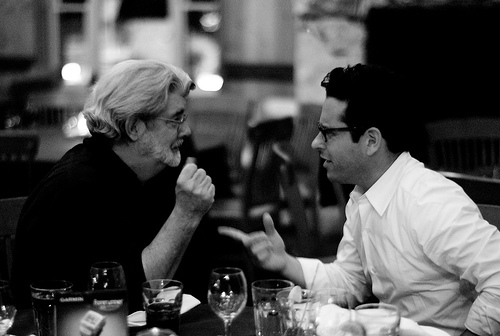Welcome to part four of my series on The Starburst Method. In this section we're going to put our summary aside and meet our characters. We're going to find out how old they are, what their traumas are, whether they like chocolate (of course!), and how they like to relax when they're not working.
This section builds on our three previous sections, which you can find here:
The Starburst Method, Part 1: Creating a one sentence summary
The Starburst Method, Part 2: Developing our one sentence summary
The Starburst Method, Part 3: Creating a five paragraph summary
The Starburst Method, Part 4: Developing characters
The Starburst Method, Part 5: Creating a five page summary
The Starburst Method, Part 6: Developing scenes
The Starburst Method, Part 7: The character grid
The Starburst Method, Part 8: The rough draft and narrative drive
The Starburst Method, Part 2: Developing our one sentence summary
The Starburst Method, Part 3: Creating a five paragraph summary
The Starburst Method, Part 4: Developing characters
The Starburst Method, Part 5: Creating a five page summary
The Starburst Method, Part 6: Developing scenes
The Starburst Method, Part 7: The character grid
The Starburst Method, Part 8: The rough draft and narrative drive
Let's get started!
4. Over the next day or two write one page of description about each of your main characters and half a page of description about each of your supporting characters.
But wait! There's more:
4.1. Character Stats. Comb through your synopsis, completed in Part 3, and write down all the character names you've used and begin a character sheet, or half-sheet, for each one. It's up to you what to include in this, but I like James Frey's division of character traits into the physiological, sociological and psychological. [2]
Physiological:
Height, weight, age, sex, culture, skin color, physical scars, beauty marks, allergies, overweight/underweight/average, hair color, eye color. What sort of clothes are hanging in your character's closet? What kind of clothes does your character wear at work? At home? When out with friends?
Sociological:
Were your character's parents wealthy? Is your character wealthy or barely making ends meet? What kind of neighborhood did your character grow up in? Did your character go to a public school? A private school? Is your character a liberal or a conservative? Are they apolitical? Is your character religious? Do they regularly attend religious gatherings? Where did your character grow up? Do they still live there? Where do they want to live?
Psychological:
Is your character intelligent? What is their IQ? Extraverted? Introverted? Has your character ever been in a serious relationship? Are they in one now? If no, do they want to be in one? Does your character have a phobia or intense fear of anything? Is your character ambitious? Does your character feel an overwhelming sense of guilt about anything? What does your character have an aptitude for? Does she have a special ability? What habits does she have? What sort of things irritate her?
Now that we've got a good basis to work from, let's discover your character's role, motivation, goal, conflict and reward. Then we'll write a very short summary of it all; a mini-story.
4.2. Role. Begin your character sheet with a sentence or two that summarizes the character's role in the story. For instance, in my story, Sir Henry is the aristocratic head of the expedition. He's the leader, the mover and shaker who brings everyone together. Although he doesn't have the money to mount the expedition himself, he has the will and the social standing to bring all the character's together. He is the catalyst. [1]
Other roles a character might have in a novel: Protagonist, Antagonist, Mentor, Shadow, Guardian, Herald, Shapeshifter, Trickster, just to name a few. Here's a link to a post I made yesterday that lists dozens of character archetypes.
4.3. Motivation. Write one paragraph about your character's motivation. Characters, like the rest of us, are motivated by one of two things: First, by something they want and, second, by something they would like to avoid. For instance, in The Fugitive, Dr. Kimble (played by Harrison Ford) is motivated to escape from the people guarding him by a train crash -- he needs to flee or he'll die. Another motivation to act is found in love stories. The hero must act in order to win the affection of his beloved.
4.4. Goal. Write one paragraph about the character's goal. Motivation generally looks backward while a goal looks forward. For instance, a character's goal might be to kill the man who bankrupted her father. The bankruptcy of her father, an event in the past, is the character's motivation, while her goal is an event planned for the future.
4.5. Conflict. Write one paragraph that develops the main conflict in the character's life. Conflict generates narrative drive, it moves a story forward. Two things that create conflict are, first, anything keeping a character from their goal and, second, raising the stakes.
Let's say that our heroine wants to kill the man (this is the antagonist of our story) who bankrupted her father. The antagonist has no idea who our heroine is is or what her plans for him are. Or so she thinks. As she closes in on the villain, the man becomes alerted to her intention and makes plans to flee (heroine is separated from her goal). Before the antagonist flees, though, he sets a lethal trap for his pursuer (raising the stakes).
Another example of raising the stakes might be: At first our heroine wants to execute the man who bankrupted her father, but then she decides that she isn't a cold-blooded murderer, but someone involved with organized crime threatens her life if she doesn't stick to her plan.
4.6 Reward. Write one paragraph about what the character's reward will be. The reward is often different from the goal. For instance, if a character's goal is to keep a church from closing her reward should be more than just the church not closing. Since she has been motivated (let's say) by the wonderful memories she had as a child coming to church with her family, her reward might be working with a philanthropist to help save other endangered buildings from the jaws of a nefarious developer. That is, I view the character's reward as broader than the goal.
4.7. Summary. Summarize everything you've discovered about your character in 100 words or less. Essentially, you want to create a short story -- a very short story -- about what happens to them. This is what I think of as a character arc.
I was going to illustrate these points with a character I have been developing though these lessons, but since this article is getting rather long I'll make that a post of its own.
In the next part of this series we will use our character sheets to expand our story. Now that we know our characters better, we will go back to the 5 paragraph plot synopsis we made in Part 3 and expand each paragraph into a page. Not a bad start!
Notes:
1. A number of years ago I had the good fortune to buy "The Weekend Novelist Writes A Mystery," by Robert J. Ray and Jack Remick. Wow! Great book. One of the things that helped me enormously was the four roles the authors advise an author to create first, before they do any serious writing: Killer, Victim Sleuth and Catalyst. See chapter one of "The Weekend Novelist," for more details.
2. How To Write A Damn Good Novel, by James N. Frey.




















